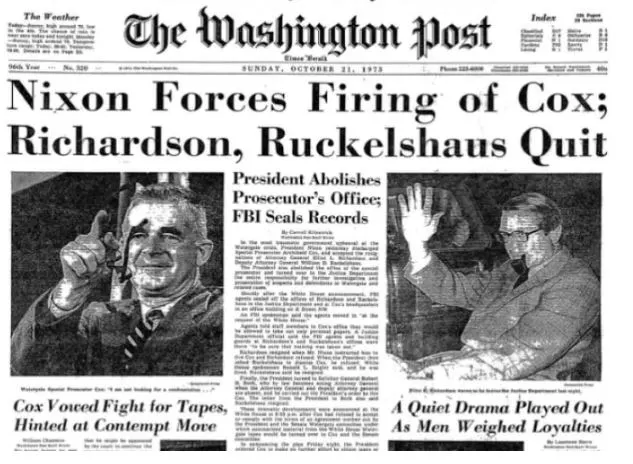The Saturday Night Massacre refers to October 20, 1973, the Saturday night when then-President Richard Nixon gave the order to fire special prosecutor Archibald Cox, leading to the resignation of his Attorney General and Deputy Attorney General.
Nixon ordered the firing of Cox after Cox subpoenaed the secret White House tapes Nixon kept, which held key information in the case against him.
Nixon ordered Attorney General Elliot Richardson to fire Cox, who would not compromise with Nixon’s attempts to delay the process in any way. Richardson refused and instead resigned.
When Deputy Attorney General William Ruckelshaus was told to fire Cox, Ruckelshaus did the same.
Finally, Solicitor General Robert Bork fired Cox, leading to outrage.
News coverage of the Massacre was harsh, and protests quickly gathered over what was seen as an abuse of power.

After the Saturday Night Massacre, polls showed for the first time that a majority of Americans wanted Nixon impeached.
Nixon would resign less than a year later.
The Nation provides a good graphic on the timeline of the event.
Use of “Saturday Night Massacre” in a sentence:
- The “Saturday Night Massacre” refers to a dramatic series of events on October 20, 1973, during the Nixon administration, when President Richard Nixon fired independent special prosecutor Archibald Cox, who was investigating the Watergate scandal.
- The term “Saturday Night Massacre” also encompasses the resignation of Attorney General Elliot Richardson and Deputy Attorney General William Ruckelshaus, who both chose to leave their positions rather than comply with Nixon’s order to fire Cox.
- The public outcry following the “Saturday Night Massacre” significantly increased pressure for impeachment proceedings against President Nixon and is considered a turning point in the Watergate saga.